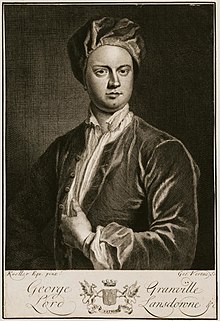George Granville, 1st Baron Lansdowne
The Lord Lansdowne | |
|---|---|
 George Granville, 1st Baron Lansdowne | |
| Secretary at War | |
| In office 1710–1712 | |
| Preceded by | Robert Walpole |
| Succeeded by | Sir William Wyndham |
| Personal details | |
| Born | Birdcage Walk, London 9 March 1666 |
| Died | 29 January 1735 (aged 68) Hanover Square, London |
| Nationality | British |
| Spouse |
Mary Villiers (m. 1711–1735) |
| Parents |
|
| Alma mater | Trinity College, Cambridge |

George Granville, 1st Baron Lansdowne
Origins
Granville was the son of
Career

Granville was sent to France at the age of ten, with his tutor, William Ellis, who was a proponent of passive resistance and later a servant of James II at St Germain. He entered
In the opinion of Samuel Johnson, Granville's non-dramatic poetry is slavishly imitative of Edmund Waller. However some of his poetry was popular in its day. Perhaps Granville's most useful act as regards poetry was the encouragement he gave to Alexander Pope, which Pope remembered with gratitude in his Epistle to Dr. Arbuthnot.
Political life

The death of Granville's parents and of his uncle the 1st Earl of Bath in 1701 placed Granville in a position of power which the accession of
After the fall of the Godolphin government, Granville became MP for
In 1714 Queen Anne was succeeded by the
Marriage
On 15 December 1711 in the church of St Martin-in-the-Fields in Westminster, London, he married (as her 2nd husband) Mary Villiers, the daughter of Edward Villiers, 1st Earl of Jersey (1656–1711) and the widow of Thomas Thynne (d. 1710).
Death and burial
He died in London on 29 January 1735, his wife having predeceased him by a few days, and was buried with her in the Church of St Clement Danes on 3 February 1735. He left no male progeny, and thus at his death the Barony of Lansdowne became extinct. His Jacobite titles, such as they were, were inherited by his nephew Bernard Granville, son of his brother Bernard. The younger Bernard died in 1776, when the Jacobite peerages created on 3 November 1721 became extinct, while those created on 6 October 1721 passed to his heir male.[11]
Works
- George Granville Lansdowne, Baron (1732). A letter to the author of Reflexions historical and political : Occasioned by a treatise In Vindication of General Monk, and Sir Richard Granville, &c. By the Right Honourable George Granville, Lord Lansdowne. London : Printed for J. Tonson in the Strand ; And L. Gilliver in Fleetstreet, MDCCXXXII.
- George Granville Lansdowne, Baron (1779-1780).The poetical works : of the Right Hon. Geo. Granville, Lord Landsdowne. With the life of the author.Edinburg : At the Apollo Press, by the Martins.
- George Granville Lansdowne, Baron. Select poems of George Granville, Lord Lansdowne. With a life of the author.Works of the British poets ... v. 17, p. [157]-203
- George Granville Lansdowne, Baron (1736). The genuine works in verse and prose, of the Right Honourable George Granville, Lord Lansdowne.London : Printed for J. and R. Tonson, at Shakespear's Head in the Strand, and L. Gilliver, J. Clarke, at Homer's Head in Fleetstreet, MDCCXXXVI
- George Granville Lansdowne, Baron (1807).The poetical works of George Granville, Lord Landsdowne [sic] : with the life of the author. Printed for Cadell and Davies ... and Samuel Bagster.
- George Granville Lansdowne, Baron (1785).Ode to Lansdown-hill, with notes, mostly relative to the Granville family : to which are added, two letters of advice from George lord Lansdown, anno MDCCXI, to William Henry earl of Bath.London : Printed by J. Nichols, for W. Randall, Pall-Mall
- George Granville Lansdowne, Baron (1732). A letter to the author of Reflexions historical and political, occasioned by a treatise in vindication of General Monk and Sir Richard Granville, &c.London : Printed for J. Tonson ..., and L. Gilliver.
- George Granville Lansdowne, Baron (1736).The genuine works in verse and prose.London : Tonson.[12]
References
- ^ J. Horace Round, Family Origins and Other Studies, ed. Page, William, 1930, p.164, The Granvilles and the Monks, p.130
- ^ J. Horace Round, Family Origins and Other Studies, ed. Page, William, 1930, p.164, The Granvilles and the Monks, p.141
- ^ "Grenville, George, Baron Lansdowne (GRNL677G)". A Cambridge Alumni Database. University of Cambridge.
- ^ a b c "GRANVILLE, George (1666-1735), of Stowe, Cornw". History of Parliament Online. Retrieved 30 June 2019.
- ^ As seen on his heraldic achievement in the Church of St James the Great, Kilkhampton, Cornwall
- ^ Haydn, Joseph, Book of Dignities (London: Longman, Brown, Green & Longman, 1851), p. 190.
- ^ Round, p.141
- ^ The new patent referred to him as "George Granvill, commonly called Lord Lansdown..." (Round, p.141)
- ^ Round, p.140
- ^ Round, p.140
- ^ Melville de Massue de Ruvigny, The Jacobite Peerage, Baronetage, Knightage & Grants of Honour (Edinburgh: T.C. & E.C. Jack, 1904), 15-16
- ^ Lansdowne, George Granville, Baron, 1667–1735 Retrieved on 10 Jan 2018.
External links
 Works by or about George Granville at Wikisource
Works by or about George Granville at Wikisource Quotations related to George Granville, 1st Baron Lansdowne at Wikiquote
Quotations related to George Granville, 1st Baron Lansdowne at Wikiquote- George Granville at the Eighteenth-Century Poetry Archive (ECPA)
- Peers informations[usurped]
